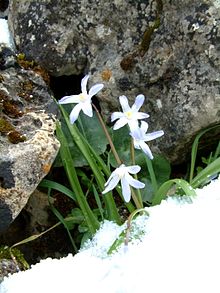Description
Like all members of Scilla sect. Chionodoxa, the bases of the stamens of Scilla nana are flattened and closely clustered in the middle of the flower. In other species of Scilla, the stamens are not flattened or clustered together.
S. nana (like S. cretica ) has two leaves per bulb, and at most one flowering stem, with one to five (more commonly three) flowers in a loose raceme. Individual flowers are up to 2.4 cm diameter with tepals up to 1.1 cm long, most facing upwards, the overall colour effect being some shade of lilac-blue. Sfikas distinguishes between smaller plants with whitish flowers occurring above 1700 m, S. nana, and larger plants with bluer flowers occurring below 1700 m, S. cretica .
S. nana subsp. albescens (synonym S. albescens) is recognized by some sources, although not by others. It has slightly smaller flowers (tepals up to 1 cm long), whitish with lavender to violet-blue tips. It was awarded the RHS Award of Garden Merit (H4 – hardy outdoors anywhere in the British Isles) in 2004, subject to availability.

Scilla is a genus of about 30 to 80 species of bulb-forming perennial herbaceous plants in the family Asparagaceae, subfamily Scilloideae. Sometimes called the squills in English, they are native to woodlands, subalpine meadows, and seashores throughout Europe, Africa and the Middle East. A few species are also naturalized in Australasia and North America. Their flowers are usually blue, but white, pink, and purple types are known; most flower in early spring, but a few are autumn-flowering. Several Scilla species are valued as ornamental garden plants.

Scilloideae is a subfamily of bulbous plants within the family Asparagaceae. Scilloideae is sometimes treated as a separate family Hyacinthaceae, named after the genus Hyacinthus. Scilloideae or Hyacinthaceae include many familiar garden plants such as Hyacinthus (hyacinths), Hyacinthoides (bluebells), Muscari and Scilla and Puschkinia. Some are important as cut flowers.

Scilla luciliae is a species of flowering plant in the family Asparagaceae. It is referred to by the common names Bossier's glory-of-the-snow or Lucile's glory-of-the-snow, and is a bulbous perennial from western Turkey that flowers in early spring. After flowering, it goes into dormancy until the next spring. The specific epithet is in honour of Lucile, the wife of the Swiss botanist Pierre Edmond Boissier (1810-1885). It belongs to a group of Scilla species that were formerly put in a separate genus, Chionodoxa, and may now be treated as Scilla sect. Chionodoxa.

Puschkinia is a genus of four known species of bulbous perennials in the family Asparagaceae, subfamily Scilloideae. It is native to the Caucasus and the Middle East. Puschkinia scilloides is grown as an ornamental bulbous plant.

Scilla section Chionodoxa, known as glory-of-the-snow, is a small group of bulbous perennial flowering plants in the family Asparagaceae, subfamily Scilloideae. Formerly treated as the separate genus Chionodoxa, they are now included in Scilla as a section. The section is endemic to the eastern Mediterranean, specifically Crete, Cyprus and Turkey. The blue, white or pink flowers appear early in the year making them valuable garden ornamentals. The common name of the group is based on the habit of flowering in high alpine zones when the snow melts in spring.
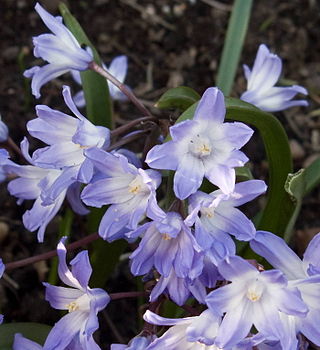
Scilla forbesii, known as Forbes' glory-of-the-snow, is a bulbous perennial plant from west Turkey flowering in early spring. It is considered synonymous with Scilla siehei, known as Siehe's glory-of-the-snow, by some sources, although others distinguish them. It belongs to a group of Scilla species that were formerly put in a separate genus, Chionodoxa, and may now be treated as Scilla sect. Chionodoxa. After flowering, it goes into dormancy until the next spring. It seeds readily to form colonies.

Scilla sardensis, the lesser glory-of-the-snow, is a bulbous perennial from west Turkey flowering in early spring. After flowering, it goes into dormancy until the next spring. It belongs to a group of Scilla species that were formerly put in a separate genus, Chionodoxa, and may now be treated as Scilla sect. Chionodoxa.
Scilla lochiae, known as Loch's glory-of-the-snow, is a bulbous perennial from Cyprus flowering in early spring. After flowering, it goes into dormancy until the next spring. It was named after Lady Loch who collected it. It belongs to a group of Scilla species that were formerly put in a separate genus, Chionodoxa, which may now be treated as Scilla sect. Chionodoxa.
Scilla × allenii is a hybrid between two species of flowering plants, both of which are now placed in the genus Scilla. One of the parents is Scilla bifolia. As of March 2020, sources differ as to the identity of the other, which may be either Scilla forbesii or Scilla luciliae.
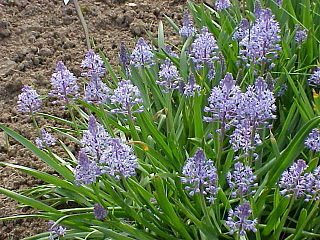
Scilla litardierei, the amethyst meadow squill or Dalmatian scilla, is a species of flowering plant in the family Asparagaceae. A bulbous perennial, with blue grape-hyacinth like flowers, blooming in late spring, much later than the more popular Siberian squill and later than Muscari which it resembles.

Hyacinthella is a genus of bulbous flowering plants in the family Asparagaceae, subfamily Scilloideae. It is native to eastern and south-eastern Europe through to northern Iran, reaching as far south as Palestine. Turkey is the main country in which species are found.

Barnardia is a small genus of bulbous flowering plants in the family Asparagaceae, subfamily Scilloideae. The genus has two species, one found in the Balearic Islands and north-west Africa, the other in east China, Korea, Japan and adjacent localities. It was suggested in 2012 that the two species were not closely related.

Dipcadi is a genus of bulbous flowering plants in the family Asparagaceae, subfamily Scilloideae. It is widely distributed, occurring in southern Europe, most of Africa and the Middle East through to the Indian subcontinent.
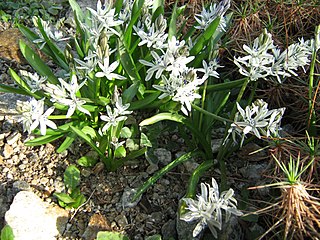
Fessia is a genus of bulbous flowering plants in the family Asparagaceae, subfamily Scilloideae. It is distributed from Iran to Central Asia and Pakistan.

Merwilla is a genus of bulbous flowering plants in the family Asparagaceae, subfamily Scilloideae. It is distributed in southern Africa, from Zimbabwe to South Africa. This genus is named after the botanist Frederick Ziervogel Van der Merwe (1894–1968), who worked on this group.
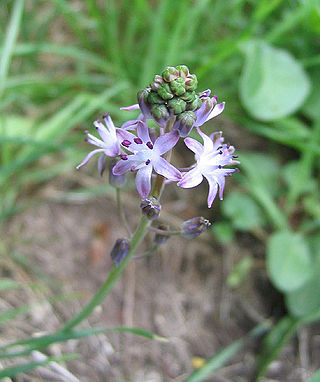
Prospero is a genus of bulbous flowering plants in the family Asparagaceae, subfamily Scilloideae. It is distributed in Europe, around the Mediterranean, and through the Middle East to the Caucasus.

Pseudoprospero is a genus of bulbous flowering plants in the family Asparagaceae, subfamily Scilloideae. The genus has a single species Pseudoprospero firmifolium, which is endemic to South Africa.

Spetaea is a monotypic genus of bulbous flowering plants in the family Asparagaceae, subfamily Scilloideae. The only known species Spetaea lachenaliiflora is found only in the south-west of the Cape Province in South Africa. Prior to 2003, it was incorrectly known as Scilla plumbea.
Scilla cretica is a species of flowering plant in the Asparagaceae family. It is referred to by the common name Cretan glory-of-the-snow, and is a bulbous perennial native to Crete, flowering in early spring. It belongs to a group of Scilla species that were formerly put in a separate genus, Chionodoxa, and may now be treated as Scilla sect. Chionodoxa. It has not always been recognized as distinct from Scilla nana.
